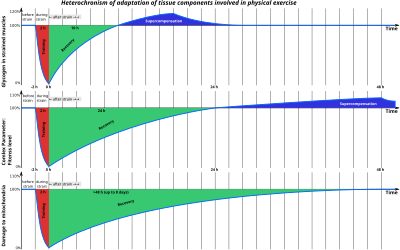This article has multiple issues. Please help improve it or discuss these issues on the talk page. (Learn how and when to remove these template messages)
|
In sports science theory, supercompensation refers to the post-training period during which the trained parameter has a higher performance capacity than it did prior to the training period.[1]

Description edit
The adaptation of the load is called supercompensation.
First put forth by Russian scientist Nikolai N. Yakovlev in 1949–1959,[2] this theory is a basic principle of athletic training. The fitness level of a human body in training can be broken down into four periods: initial fitness, training, recovery, and supercompensation. During the initial fitness period, the target of the training has a base level of fitness. Upon entering the training period, the target's level of fitness decreases. After fitness training, the body enters the recovery period, during which the level of fitness increases up to the initial fitness level.
Because the human body is an adaptable organism, it will feel the need to adapt itself to a higher level of fitness in anticipation of the next training session. Accordingly, the increase in fitness following a training session does not stop at the initial fitness level. Instead, the body enters a period of supercompensation during which fitness surpasses the initial fitness level. If there are no further workouts, this fitness level will slowly decline back towards the initial fitness level (shown by the last time sector in the graph).
If the next workout takes place during the recovery period, overtraining may occur. If the next workout takes place during the supercompensation period, the body will advance to a higher level of fitness. If the next workout takes place after the supercompensation period, the body will remain at its base level.
Sometimes a few workouts are intentionally made in the recovery period to try to achieve greater supercompensation effects.[3]
Supercompensation–training programs relation edit
This process is based on various physiological functions and parameters. Each of these functions or parameters has distinct recovery times, timeframes to reach supercompensation, and intervals between the peak and return to baseline fitness.
Other influences are muscle strength and mass. For instance, muscle mass is influenced by the quantity of glycogen in the muscles, among others.
Uses edit
In classical sport science, the yearly (sometimes multi-yearly) period is divided into micro and macro cycles, where each microcycle is responsible for the development of a specific (sometimes several) basic training function and parameter, whereas macrocycles are responsible for the development of complex parameters/functions (such as muscle strength).
References edit
- ^ "Defining supercompensation training". human-kinetics. March 9, 2009.
- ^ Viru, Atko (April 17, 2002). "Early contributions of Russian stress and exercise physiologists". Journal of Applied Physiology. 92 (4): 1378–1382. doi:10.1152/japplphysiol.00435.2001. PMID 11896000. S2CID 1216297.
- ^ Marrier, Bruno; Robineau, Julien; Piscione, Julien; Lacome, Mathieu; Peeters, Alexis; Hausswirth, Christophe; Morin, Jean-Benoît; Meur, Yann Le (2017-01-25). "Supercompensation Kinetics of Physical Qualities During a Taper in Team Sport Athletes". International Journal of Sports Physiology and Performance. 12 (9): 1163–1169. doi:10.1123/ijspp.2016-0607. ISSN 1555-0265. PMID 28121198.
External links edit
- Shea, Jason. "Fatigue, Recovery, and Supercompensation" (PDF).
- Bompa, Tudor O.; Haff, Greg (10 August 2009). Periodization: theory and methodology of training. Human Kinetics. pp. 18–. ISBN 978-0-7360-8547-2. Retrieved 30 September 2011.
- Janssen, Peter G. J. M. (2001). Lactate threshold training. Human Kinetics. pp. 151–. ISBN 978-0-7360-3755-6. Retrieved 30 September 2011.
- Fee, Earl W. (30 April 2005). The Complete Guide To Running: How To Be A Champion From 9 To 90. Meyer & Meyer Verlag. pp. 119–. ISBN 978-1-84126-162-1. Retrieved 30 September 2011.